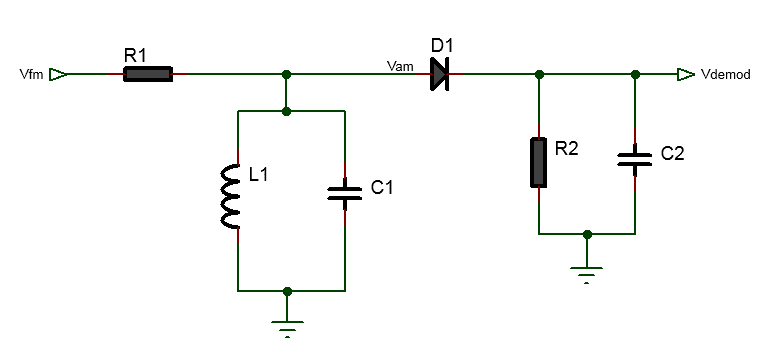FM Slope Detector
A slope detector is a widely used method for demodulating Frequency Modulation (FM) signals. Demodulation is the process or method to extract message signal or information embedded in modulated signal, in this case frequency modulated signal. Demodulator are called detector and also discriminator. Usually phase or frequency are discriminated in phase modulated or frequency modulated signal hence such circuit are called phase or frequency discrimination circuit. Thus the slope detector circuit is also called frequency discrimination circuit. This circuit operates by detecting the variations in the input signal’s slope to obtain the original modulating signal. It uses tuned LC circuit at the front, followed by diode rectification and low pass filtering. It is similar to AM envelope detector circuit except the tuned circuit. It is a simple method for FM demodulation. Here it is discussed how to to design FM slope detector.
Working Principle of Slope Detector Circuit
The following shows the FM slope detector circuit diagram.
The slope detector circuit consist of LC tuned circuit made up of L1 and C1 which is tuned slightly higher than the carrier frequency((f_c)). The FM signal enters into this LC tuned circuit via the resistor R1. This resistor is a timing resistor which with the capacitor C1 controls the charging time of the capacitor. The output of from the LC tuned circuit is an amplitude and frequency modulated signal. Then the resulting AM signal is passed into the diode D1 detector circuit. The rectified output from the diode is then low pass filtered using RC filter made up of the resistor R2 and capacitor C2. The RC passive filter removes the ripples from a signal. The diode detector together with the filter is called envelope detector. Thus FM slope detector is LC tuned circuit connected to an envelope detector.
As a whole the circuit is called slope detector because the tuned circuit is designed based on the slope on the tuned circuit frequency response graph. The following shows the frequency response graph of the tuned circuit and the slope which is dependent on the frequency and amplitude of the received FM signal carrier frequency.
The graph shows the extend or range of the output voltage of the tuned circuit, developed across the capacitor, due to the amplitude of the received carrier signal. When the carrier signal amplitude is low the voltage across the capacitor is lowered and when the amplitude of the carrier signal is high the voltage across the capacitor gets higher. The extend of this output voltage depends on the amplitude of the carrier signal makes a slope and hence this circuit is called slope detector.
In other words, when FM signal is applied to a tuned circuit, the signal after the tuned circuit is a hybrid signal whose amplitude and frequency both are dependent on the message signal. Even further, the output signal from the tuned circuit has slope dependent factor besides the transmission bandwidth, carrier signal amplitude and constant factor plus bias term. The bias term is removed by balanced slope detector circuit which is improved version of this single slope detector circuit.
Design of FM slope detector
Consider that the FM signal has carrier signal of 100KHz and that the embedded message signal has frequency of 10KHz. We should note that, if the FM transmission bandwidth is B then it is
essential that the resonant frequency of the tuned circuit be within the
fc – B/2 < |fr| < fc+B/2 range. For example if the transmission bandwidth is B=10KHz then the tuned circuit resonant frequency should in the range 100KHz-5KHz < |fr| <100KHz+5Hz, that is, 95KHz < |fr| <105KHz.
The first step is to design the LC resonant tank circuit whose resonant
frequency (f_r) is slightly higher than the carrier frequency(f_c). Let the resonant frequency (f_r) of the tuned circuit be 105KHz. Let us choose a capacitor of C1=10nF then we can use the online LC tank circuit calculator to determine the value of the inductor L1. The calculated value is L1=229.99uH. Next we need to design the low pass filter. Since the modulating signal is 10KHz let the cutoff frequency of the low pass filter be 12KHz. Let the value of the capacitor be C2=10nF then we can use the online low pass filter calculator to determine the value of resistor R2 which turns out to be 1.33KΩ. The value of the resistor R1 was chosen as 1KΩ for adequate charging.
The completed frequency modulation slope detector circuit design with component values is shown below.
The designed slope detector circuit was driven by 100KHz, 1V amplitude FM signal carrying 1V amplitude, 10KHz modulating signal. The following graph shows the modulating signal, the FM signal, the AM signal after the tuned circuit and the demodulated or recovered modulating or message signal.
The demodulated or recovered signal has ripples and the amplitude is very small. A non-inverting operational amplifier followed by coupling capacitor was used to amplify the demodulated signal. Below is the circuit diagram and the waveform graph after the amplifier was used.
As can be seen the ripples are less and the amplitude has been increased using the operational amplifier.
Summary
Overall, here we explained what FM slope detector is and how it is used to
demodulate frequency modulated signal sent from FM transmitter. A design
example was provided and how to calculate the component values was
illustrated. Tthe slope detector inexpensive and simple method of FM demodulation. With careful component selection and circuit design, it can provide good demodulation performance.
Further Readings and References






